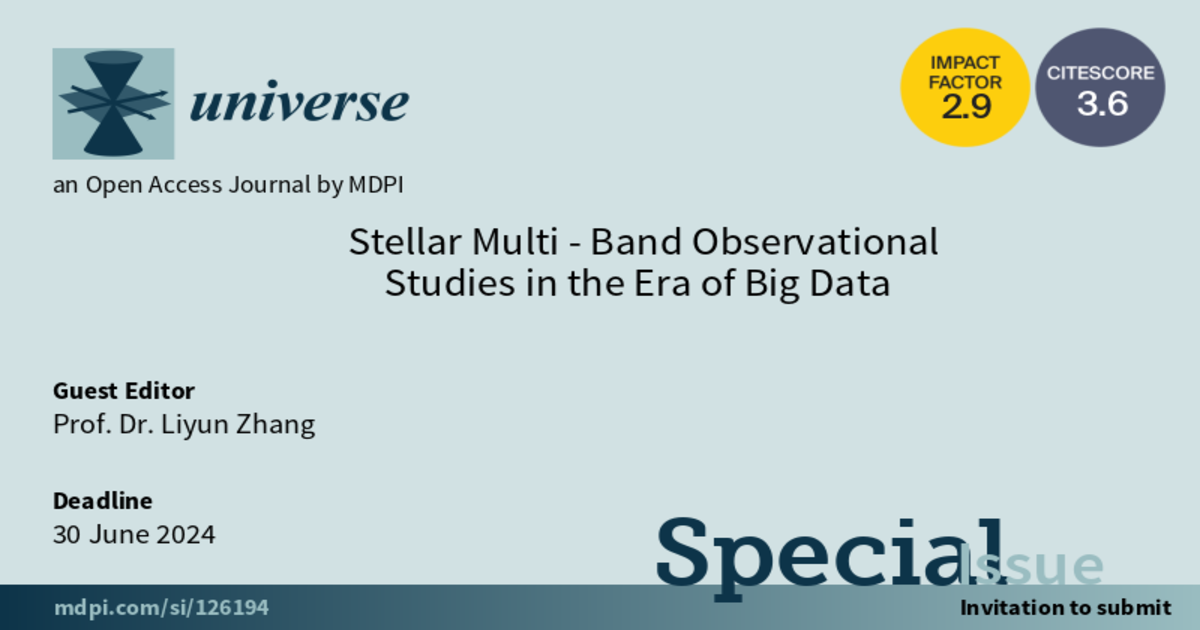Stellar Multi-Band Observational Studies in the Era of Big Data
A special issue of Universe (ISSN 2218-1997). This special issue belongs to the section "Stellar Astronomy".
Deadline for manuscript submissions: 30 June 2024 | Viewed by 4341

Special Issue Editor
Special Issue Information
Dear Colleagues,
Astronomy has entered the era of big data with all band observations. It is one of the most important astronomical topics related to the statistical analysis concerning stellar physics using big data from multi-band sky surveys. To date, we can determine stellar parameters and the intensity of different wavelengths. It is necessary to fully understand stellar physical properties, structure, and other special physical process phenomena, such as magnetic activity. Using the Gaia survey, we can also obtain the stellar distance and determine the spatial and magnetic activity distributions of different types of variable stars in the Milky Way. For example, we can obtain stellar spectroscopic parameters (such as the temperature, spectral type, radial velocity, log, and chemical abundance), and determine the properties and behavior of spectral lines using the SDSS and LAMOST time-series of low- and medium-resolution spectroscopic surveys, which have produced over ten million stellar large-sample data. We can also determine stellar orbital periods and calculate the parameters of starspot and flare events using Kepler and TESS photometric surveys. Moreover, we can explore the relationship between the intensities of stellar activity and stellar physical parameters (such as the orbital period and temperature) for variable stars. Finally, we can reveal the radiation of all wavelengths of the different variable stars in the Hertzsprung–Russell diagram. We also intend to present the relationships among the intensities of multi-bands from the optical spectral survey of the Guoshoujing telescope, VLA FIRST radio survey, the data of the 500 meter spherical radio telescope (FAST) and SKA, X-ray band and UV wavelengths. This project can not only more accurately determine the relationships of the different wavelengths, but can also reveal the laws between stellar physical parameters and activities in more detail.
Prof. Dr. Liyun Zhang
Guest Editor
Manuscript Submission Information
Manuscripts should be submitted online at www.mdpi.com by registering and logging in to this website. Once you are registered, click here to go to the submission form. Manuscripts can be submitted until the deadline. All submissions that pass pre-check are peer-reviewed. Accepted papers will be published continuously in the journal (as soon as accepted) and will be listed together on the special issue website. Research articles, review articles as well as short communications are invited. For planned papers, a title and short abstract (about 100 words) can be sent to the Editorial Office for announcement on this website.
Submitted manuscripts should not have been published previously, nor be under consideration for publication elsewhere (except conference proceedings papers). All manuscripts are thoroughly refereed through a single-blind peer-review process. A guide for authors and other relevant information for submission of manuscripts is available on the Instructions for Authors page. Universe is an international peer-reviewed open access monthly journal published by MDPI.
Please visit the Instructions for Authors page before submitting a manuscript. Submitted papers should be well formatted and use good English. Authors may use MDPI's English editing service prior to publication or during author revisions.
Keywords
- variable star
- eclipsing binary
- photospheric starspot
- chromospheric activity
- corona
- flare
- radio
- X-ray
- big data
- statistic





